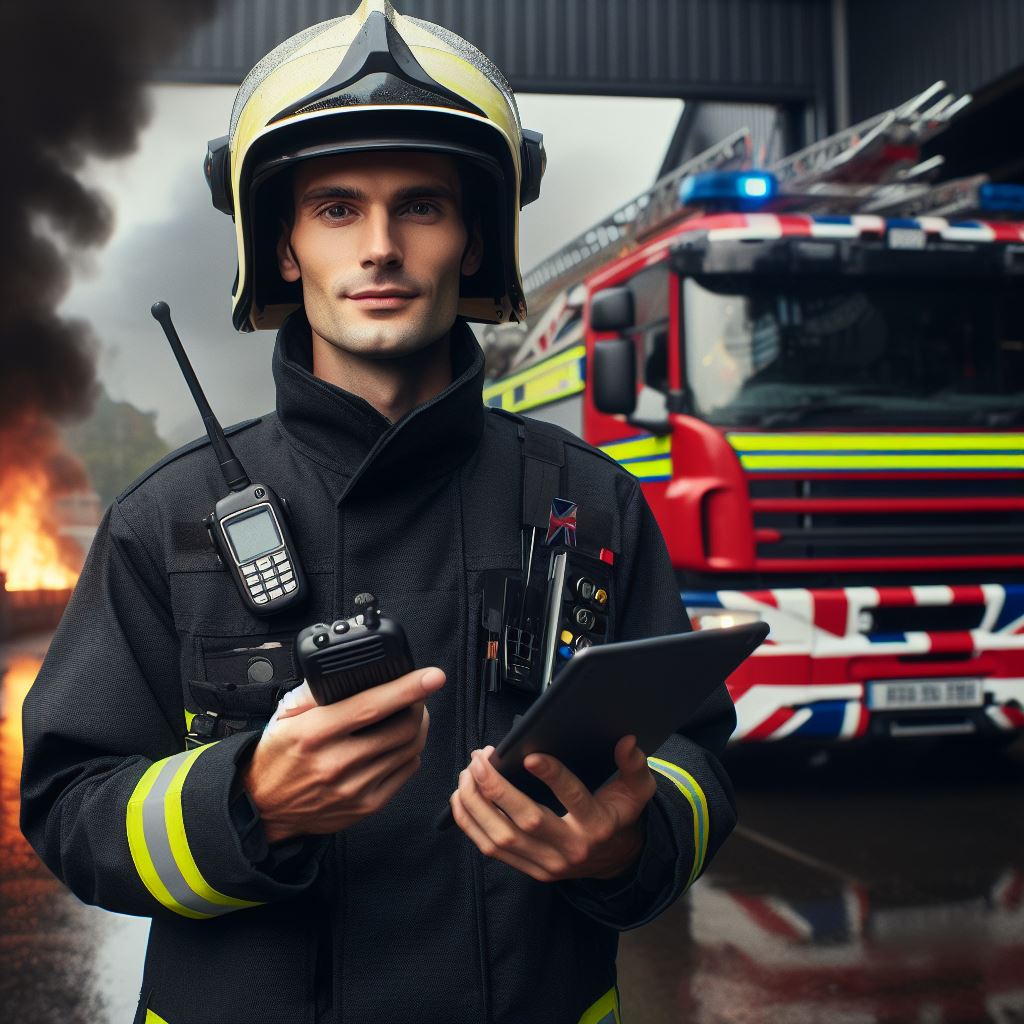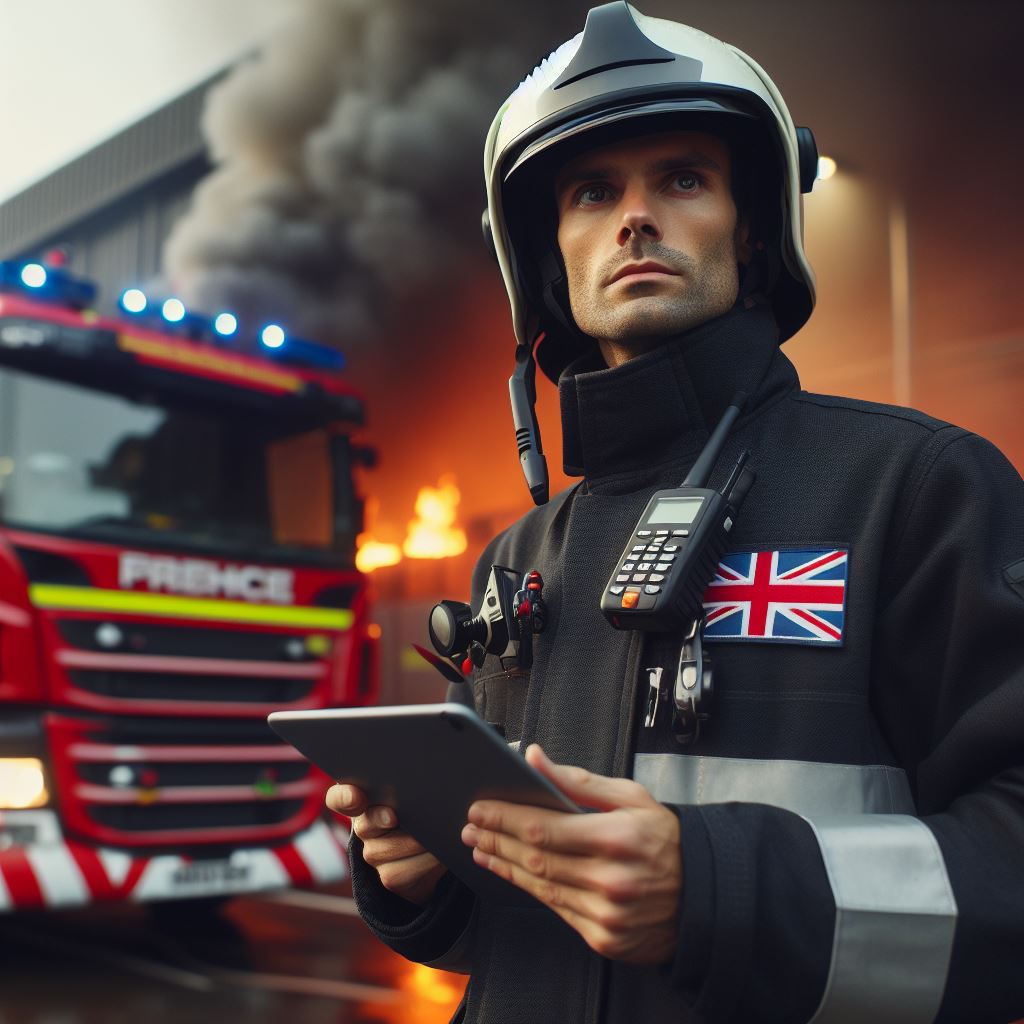Introduction
In the UK, firefighting technology plays a crucial role in ensuring the safety of firefighters and the public. Continuously updating these techniques is of utmost importance.
Firefighting technology has significantly evolved over the years in the UK, keeping pace with the changing fire risks and challenges faced by firefighters.
New innovations in equipment and techniques have emerged, enhancing the effectiveness and efficiency of firefighting operations.
The significance of continuously updating firefighting techniques cannot be overstated.
These advancements aid in minimizing risks and improving the safety of both firefighters and the communities they serve.
The UK boasts cutting-edge firefighting tools like enhanced thermal imaging cameras, unmanned aerial systems, and advanced personal protective equipment.
These innovations enable firefighters to better assess fire dynamics, locate victims, and navigate hazardous environments with enhanced precision and safety.
Moreover, technology integration has led to the creation of sophisticated control systems, enabling real-time data monitoring and analysis during firefighting operations.
By leveraging data-driven insights, firefighters can make informed decisions, respond more effectively, and optimize resource allocation.
Communication technology advances enhance coordination among firefighting teams, resulting in quicker responses and more efficient incident management.
Overall, firefighting technology holds immense significance in the UK, given its critical role in ensuring the safety of both firefighters and the public.
Continuous updates and innovations in this field are essential for enhancing firefighting capabilities and protecting lives.
Historical Overview of Firefighting Technology
Brief history of firefighting technology in the UK
Firefighting technology in the UK has evolved significantly over the years, driven by the continuous need to improve fire prevention and suppression methods.
Let’s take a brief look at the history of firefighting technology in the UK
Early Methods
- Manual firefighting techniques were initially employed, where courageous individuals fought fires using hand-operated tools.
- Basic tools such as buckets, hooks, and ladders were used to combat fires during this period.
Challenges Faced
However, these early methods presented various challenges:
Personalized UK Career Consulting
Receive tailored career guidance designed just for you. Get actionable steps and expert support to boost your career in 1-3 days. Take control of your career now.
Get Started- With limited technology, time was of the essence in alerting firefighters and gathering sufficient personnel.
- Communication infrastructure was lacking, making it difficult to coordinate firefighting efforts.
- Accessibility to water sources was a concern, as nearby bodies of water were not always readily available.
The Need for Advancements
The need for advancements in firefighting technology became apparent:
- In the late 17th century, firefighting technology advanced with the introduction of manual water pumps.
- The first organized municipal fire brigade was formed in Edinburgh in 1824.
- Steam-powered fire engines were developed in the early 19th century, combining the benefits of manual and mechanical firefighting.
- Fire hydrants were installed in urban areas, providing a more reliable and accessible water supply for firefighting efforts.
- Improved communication systems, including fire alarms and telegraph systems, enabled faster response times.
- The invention of fire-resistant building materials such as concrete and steel enhanced fire safety measures.
- Specialized firefighting vehicles, including aerial ladder platforms and turntable ladders, were introduced in the early 20th century.
Recent Advancements
As technology advanced further, other significant advancements followed:
- Introduction of fire-resistant clothing and personal protective equipment (PPE) to enhance firefighter safety.
- Incorporation of thermal imaging cameras and gas detection monitors to aid in locating and assessing fires.
- Development of high-pressure water mist systems, which can effectively extinguish fires while minimizing water damage.
- Implementation of computerized fire alarm systems and fire suppression systems in buildings.
- Utilization of robotic firefighting machines for tasks too hazardous or inaccessible for humans.
Firefighting technology in the UK continues to advance rapidly, focusing on improving firefighter safety and effectiveness in combating fires.
The ongoing research and development in this field ensure that the UK remains at the forefront of firefighting innovation.
In short, the historical overview of firefighting technology in the UK highlights the significant progress made throughout the years.
From manual firefighting techniques to advanced robotic machines, advancements have revolutionized the way fires are prevented and suppressed.
Despite the challenges faced in the past, the continuous need for advancements has shaped the modern fire service into a highly skilled and technologically equipped force.
Read: Women in UK Firefighting: Breaking Barriers
Advancements in Firefighting Equipment
Innovations in firefighting gear and personal protective equipment (PPE)
Firefighting technology has witnessed remarkable advancements in recent years, particularly in the development of firefighting gear and PPE.
These innovations aim to enhance the safety and effectiveness of firefighters on the frontlines.
Modern firefighting helmets, breathing apparatus, and fire-resistant clothing
Modern firefighting helmets
- One of the key innovations in PPE is the modern firefighting helmet.
- These helmets are designed to provide superior protection to the firefighter’s head, face, and neck.
- They incorporate features such as thermal imaging cameras, integrated communication systems, and impact-resistant materials.
Breathing apparatus
- The introduction of advanced breathing apparatus has revolutionized firefighting operations.
- These apparatus enable firefighters to breathe in hazardous environments by providing a continuous supply of clean air.
- They are equipped with improved filtration systems and enhanced communication capabilities.
Fire-resistant clothing
- Fire-resistant clothing plays a crucial role in protecting firefighters from heat, flames, and other hazards.
- Modern fire-resistant fabrics are lightweight, flexible, and offer higher levels of thermal protection.
- They are designed to resist ignition and prevent the spread of flames, providing firefighters with valuable seconds to escape dangerous situations.
Importance of lightweight and ergonomic designs
In addition to superior protection, manufacturers have recognized the significance of lightweight and ergonomic designs in firefighting equipment.
Lightweight gear allows firefighters to move swiftly, reducing fatigue and improving overall agility during rescue operations.
Ergonomic designs ensure proper weight distribution, enhancing balance, mobility, and reducing the risk of injuries.
Enhanced mobility
- Firefighters often face physically demanding situations that require them to climb ladders, crawl through confined spaces, and carry heavy equipment.
- Lightweight gear and PPE development enhances firefighter maneuverability, enabling effective duty performance while minimizing physical strain.
Improved safety
- Lightweight and ergonomic designs not only contribute to enhanced mobility but also improve the safety of firefighters.
- By reducing the weight carried by firefighters, these advancements minimize the risk of musculoskeletal injuries.
- Enhanced mobility and reduced fatigue enable firefighters to respond swiftly and effectively, ultimately saving lives.
In closing, advancements in firefighting equipment and PPE have significantly improved the safety and effectiveness of firefighters in the UK.
Your Dream Job Starts with a Perfect CV
Get a tailored CV and cover letter that captures your unique strengths and stands out in your industry. Let us help you make an unforgettable first impression.
Get StartedThe incorporation of modern firefighting helmets, breathing apparatus, and fire-resistant clothing has provided enhanced protection in hazardous situations.
Moreover, the emphasis on lightweight and ergonomic designs has greatly improved mobility and overall safety.
As technology advances, the future of firefighting promises better tools for frontline heroes, ensuring they are equipped to combat emergencies effectively.
Read: Fire Safety Education: A UK Firefighter’s Role
Introduction of New Fire Suppression Techniques
In recent years, the fire service industry in the UK has witnessed incredible advancements in fire suppression technologies.
Firefighters are now equipped with innovative tools and techniques that have revolutionized their ability to extinguish fires efficiently.
Explore new fire suppression techniques, including alternative extinguishing agents like compressed air foam systems (CAFS) and water mist, in this section.
Use of Alternative Extinguishing Agents
One remarkable innovation in the field of fire suppression is the adoption of compressed air foam systems (CAFS).
Traditionally, water has been the primary extinguishing agent used by firefighters.
However, CAFS combines water, foam concentrate, and compressed air to create a powerful and versatile fire suppression solution.
Water mist is another alternative extinguishing agent that has gained popularity in recent years.
This technology involves the conversion of water into tiny droplets using high-pressure systems, creating a mist-like effect.
The water mist is then directed towards the fire, suppressing it effectively.
Improving Fire Suppression Efficiency and Minimizing Property Damage
These new technologies have significantly improved fire suppression efficiency.
Optimize Your LinkedIn for Success
Boost your LinkedIn profile with a professional bio, keyword-rich headline, and strategic recommendations that attract recruiters. Stand out from the crowd and get noticed.
Optimize NowThe use of CAFS allows firefighters to create a thick foam blanket that covers and cools the fire source quickly, reducing the oxygen supply and extinguishing the flames faster.
This rapid-fire suppression capability translates into minimized property damage.
Water mist technology also enhances fire suppression efficiency.
The fine water droplets generated by high-pressure systems increase the surface area coverage, ensuring that the entire fire area is targeted.
This comprehensive coverage enables quicker extinguishment of the fire and reduces the risk of re-ignition.
Benefits of Alternative Fire Suppression Technologies
The adoption of CAFS and water mist technology brings numerous benefits to the firefighting industry.
- Firstly, these technologies result in reduced water usage.
Traditional fire suppression methods require large volumes of water, leading to water wastage and potential environmental concerns. - The use of alternative agents minimizes this water consumption and promotes more sustainable firefighting practices.
- Furthermore, these innovations prioritize firefighter safety.
CAFS and water mist systems enable firefighters to combat fires from a safer distance. - The foam generated by CAFS acts as a barrier, reducing the risk of direct exposure to flames.
- Water mist, on the other hand, provides a cooling effect that protects firefighters from heat-related injuries.
On a final note, new fire suppression techniques, including compressed air foam systems (CAFS) and water mist, revolutionize the UK fire service industry.
These technologies offer improved fire suppression efficiency, minimized property damage, reduced water usage, and increased firefighter safety.
As the industry continues to evolve, it is crucial to embrace such innovations to enhance firefighting capabilities and ensure the safety of both firefighters and the community.
Read: Firefighters and PTSD: The Untold UK Story

Advanced Firefighting Vehicles and Tools
The evolution of fire engines and their capabilities
The evolution of fire engines and their capabilities has greatly contributed to enhancing firefighting efforts.
Today, firefighters have access to advanced vehicles and tools that enable them to combat fires more effectively and efficiently.
Information about aerial ladder platforms, rescue vehicles, and cutting-edge firefighting tools
Fire Engines
- Fire engines have undergone significant transformations over the years to meet the growing needs of firefighting.
- Modern fire engines are equipped with sophisticated equipment and technology to handle various types of emergencies.
- They are equipped with powerful water pumps, large water tanks, and a range of firefighting tools and equipment.
- These engines are designed to transport firefighters, water, and equipment to the scene of a fire.
- Their primary function is to pump water onto the fire to suppress and extinguish the flames.
Aerial Ladder Platforms
- Aerial ladder platforms are specialized fire apparatuses that provide firefighters with access to elevated positions.
- These vehicles are equipped with hydraulic ladder systems that can reach great heights, allowing firefighters to rescue people trapped in high-rise buildings.
- They also have water cannons mounted on top, enabling them to deliver water directly to the fire from above.
- Aerial ladder platforms significantly enhance firefighters’ capabilities in tackling fires in tall buildings.
Rescue Vehicles
- Rescue vehicles are designed to assist firefighters in performing complex rescue operations.
- These vehicles are equipped with specialized tools such as cutting and extraction equipment.
- They can efficiently extricate individuals from vehicles involved in accidents or rescue people trapped in collapsed structures.
- Rescue vehicles often carry medical equipment to provide immediate medical attention to those in need.
Cutting-edge Firefighting Tools
- In addition to advanced vehicles, firefighters are equipped with cutting-edge tools to combat fires.
- Thermal imaging cameras help identify hidden hotspots, making firefighting more efficient.
- Firefighters also use firefighting foam, which can suppress and extinguish fires more effectively.
- Portable firefighting equipment such as fire extinguishers and hose reels are essential tools for rapid intervention.
Importance of regularly updating the fleet to improve response times and efficiency
- Regularly updating the firefighting fleet is of utmost importance.
- This ensures that firefighters have access to the latest technology and equipment to respond to emergencies promptly.
- Updating the fleet has several advantages, including improved response times and enhanced operational efficiency.
- Innovations in firefighting vehicles and tools enable firefighters to tackle emergencies more effectively, minimizing property damage and saving lives.
- Moreover, as fire risks and challenges continue to evolve, the need for advanced firefighting capabilities becomes even more crucial.
To sum it up, the advancements in firefighting vehicles and tools have revolutionized the way firefighters combat fires.
From modern fire engines to specialized vehicles and cutting-edge tools, the firefighting industry is continually evolving to improve response times and efficiency.
Regularly updating the fleet is essential in ensuring firefighters have the necessary resources to protect lives and property from the devastating impact of fires.
Read: The Future of Firefighting in the United Kingdom
See Related Content: Technology’s Role in Civil Service
Incorporation of Technology into Firefighting
Technological advancements have revolutionized the firefighting industry, augmenting firefighters’ capabilities and improving overall safety
The use of digital tools for fire prevention and incident management
- Firefighters utilize advanced software and analytics to predict fire risks and plan accordingly.
- Sensors and monitoring systems constantly collect data to detect early signs of fire hazards.
- Real-time monitoring of high-risk areas enhances situational awareness and facilitates prompt response.
- Mobile applications provide firefighters with instant access to critical information and communication tools.
- Virtual reality simulations prepare firefighters for various scenarios and improve their decision-making skills.
The implementation of fire alarm systems, smoke detectors, and sprinkler systems
- Fire alarm systems use cutting-edge technology to detect smoke, heat, and combustion gas levels.
- Advanced smoke detectors quickly identify the presence of smoke particles and trigger alarms.
- Sprinkler systems automatically activate in response to fire, limiting its spread and minimizing damage.
- Intelligent systems can distinguish between false alarms and genuine fire emergencies, reducing unnecessary responses.
- Smart systems can also notify relevant authorities and provide real-time data on fire incidents.
The use of drones in identifying fire hotspots and assisting with search and rescue operations
- Drones equipped with thermal imaging cameras can identify hidden fire hotspots within burning structures.
- Firefighters can remotely pilot drones to access dangerous or hard-to-reach areas during firefighting operations.
- Drones aid in surveying large areas and provide aerial perspectives for efficient decision-making.
- These unmanned aerial vehicles enable search and rescue teams to locate missing persons in hazardous environments.
- Live video feeds from drones assist incident commanders in assessing the severity of the situation and strategizing response.
In a nutshell, the integration of technology into firefighting has revolutionized the industry, empowering firefighters with advanced tools.
Digital innovations have enhanced fire prevention and incident management, ensuring prompt and effective responses.
Fire alarm systems, smoke detectors, sprinkler systems, and drones have significantly improved safety levels, reducing risks and saving lives.
See Related Content: Pension Schemes for UK Gov Officers
Training and Education in Firefighting Technology
As technology continues to advance, training and education for firefighters have become more essential than ever before.
Providing comprehensive training on new technologies is of utmost importance in ensuring the safety and efficiency of firefighters during emergencies.
Importance of Providing Comprehensive Training on New Technologies
Firefighting technology is constantly evolving, with new tools and equipment being introduced to enhance the capabilities of firefighters.
However, without proper training, these advancements may not be utilized effectively.
Comprehensive training helps firefighters grasp new technology features, functions, and limitations, enabling informed decisions in critical situations.
Training programs should cover a wide range of new technologies, including thermal imaging cameras, drones, robotic systems, and advanced communication devices.
This knowledge equips firefighters with the necessary skills to operate these tools efficiently, enhancing their effectiveness on the field.
Incorporation of Virtual Reality (VR) and Simulators for Realistic Training Scenarios
- One innovative approach to training is the use of virtual reality (VR) and simulators to create realistic training scenarios.
- VR technology immerses firefighters in virtual environments that simulate real-life emergency situations.
- This immersive experience helps them develop critical decision-making skills, spatial awareness, and situational awareness.
- Simulators, on the other hand, provide practical hands-on training without exposing firefighters to actual danger.
- These simulators replicate the operation of various firefighting equipment, allowing firefighters to practice using them in a controlled environment.
- By repeatedly practicing in different simulated scenarios, firefighters can improve their response times and decision-making abilities.
- Both VR and simulators contribute to reducing the risks associated with live training exercises while providing trainees with a realistic and immersive learning experience.
Role of Ongoing Education in Keeping Firefighters Up-to-Date with the Latest Innovations
- Firefighting technology is continuously evolving, with new innovations emerging regularly.
- Ongoing education plays a vital role in keeping firefighters updated with these advancements.
- By attending workshops, seminars, and specialized courses, firefighters can stay ahead of the curve when it comes to the latest technologies.
- Continuing education also allows firefighters to learn from experts and researchers in the field.
- These opportunities provide valuable insights and knowledge-sharing that can enhance the effectiveness of firefighting operations.
- Ongoing education promotes a culture of lifelong learning among firefighters, fostering adaptability and innovation in the firefighting community.
- Additionally, ongoing education can help firefighters understand the implications of technological advancements on their profession.
- They can delve into ethical considerations, legal implications, and best practices for responsibly and safely handling and implementing new technologies.
All in all, comprehensive training and ongoing education are integral components in preparing firefighters for the challenges posed by advancements in firefighting technology.
Equip firefighters with essential knowledge and skills, offer continuous learning opportunities, enabling them to adapt to new technologies and save lives.
Learn More: Navigating Scandals: UK Politicians’ Strategies
Conclusion
In this blog, we explored the advancements in firefighting technology in the UK.
From drone usage for aerial surveillance to augmented reality for training, these innovations have had a profound positive impact on the efficiency and effectiveness of firefighting operations.
We highlighted the benefits of thermal imaging cameras, which enable firefighters to locate victims and navigate through smoke-filled environments with ease.
Additionally, the integration of GPS technology in fire engines has improved response times and enabled better coordination during emergencies.
Furthermore, the development of high-pressure water mist systems has revolutionized fire suppression techniques, minimizing water damage and reducing the risk of injury to both firefighters and the public.
It is evident that these cutting-edge technologies are continuously evolving to address the challenges faced by firefighters.
Efforts are being made to improve communication systems, provide real-time data on fire conditions, and enhance protective gear.
The positive impacts of these innovations cannot be overstated. Lives are being saved, and property damage is being minimized more effectively than ever before.
The investments in technology and research are ensuring the safety and well-being of both firefighters and the public.
In review, the UK firefighting community’s dedication to continuous improvement in techniques and equipment is commendable.
As technology advances, so does the ability to protect lives and property.
Through ongoing efforts, the UK remains at the forefront of firefighting innovation, leading the way for a safer future for all.
[E-Book for Sale]
500 Cutting-Edge Tech Startup Ideas for 2024 & 2025: Innovate, Create, Dominate
$19.99 • 500 Tech Startup Ideas • 62 pages
You will get inspired with 500 innovative tech startup ideas for 2024 and 2025, complete with concise descriptions to help you kickstart your entrepreneurial journey in AI, Blockchain, IoT, Fintech, and AR/VR.




